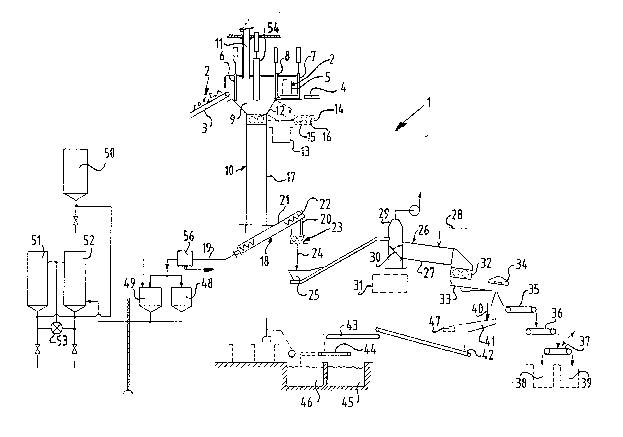Some of the information on this Web page has been provided by external sources. The Government of Canada is not responsible for the accuracy, reliability or currency of the information supplied by external sources. Users wishing to rely upon this information should consult directly with the source of the information. Content provided by external sources is not subject to official languages, privacy and accessibility requirements.
Any discrepancies in the text and image of the Claims and Abstract are due to differing posting times. Text of the Claims and Abstract are posted:
| (12) Patent Application: | (11) CA 2059023 |
|---|---|
| (54) English Title: | METHOD AND DEVICE FOR TREATING WASTE |
| (54) French Title: | METHODE ET DISPOSITIF POUR LE TRAITEMENT DES DECHETS |
| Status: | Deemed Abandoned and Beyond the Period of Reinstatement - Pending Response to Notice of Disregarded Communication |
| (51) International Patent Classification (IPC): |
|
|---|---|
| (72) Inventors : |
|
| (73) Owners : |
|
| (71) Applicants : |
|
| (74) Agent: | SMART & BIGGAR LP |
| (74) Associate agent: | |
| (45) Issued: | |
| (22) Filed Date: | 1992-01-08 |
| (41) Open to Public Inspection: | 1993-07-09 |
| Examination requested: | 1998-09-16 |
| Availability of licence: | N/A |
| Dedicated to the Public: | N/A |
| (25) Language of filing: | English |
| Patent Cooperation Treaty (PCT): | No |
|---|
| (30) Application Priority Data: | None |
|---|
P HP/LS/LR-1
ABSTRACT
The invention relates to a method for treating waste
comprising the steps of:
i) shredding the waste;
ii) separating liquid;
iii) subjecting the separated solid waste to a cold treatment;
and
iv) separating product remnants,
and to a device for treating waste, comprising:
i) a shredder unit;
ii) a unit for separating liquid out of the shredded
material;
iii) a cold treatment unit for the shredded material; and
iv) a unit for separating product remnants.
Note: Claims are shown in the official language in which they were submitted.
Note: Descriptions are shown in the official language in which they were submitted.

2024-08-01:As part of the Next Generation Patents (NGP) transition, the Canadian Patents Database (CPD) now contains a more detailed Event History, which replicates the Event Log of our new back-office solution.
Please note that "Inactive:" events refers to events no longer in use in our new back-office solution.
For a clearer understanding of the status of the application/patent presented on this page, the site Disclaimer , as well as the definitions for Patent , Event History , Maintenance Fee and Payment History should be consulted.
| Description | Date |
|---|---|
| Inactive: IPC deactivated | 2011-07-26 |
| Inactive: First IPC derived | 2006-03-11 |
| Inactive: IPC from MCD | 2006-03-11 |
| Inactive: IPC from MCD | 2006-03-11 |
| Time Limit for Reversal Expired | 2000-01-10 |
| Application Not Reinstated by Deadline | 2000-01-10 |
| Deemed Abandoned - Failure to Respond to Maintenance Fee Notice | 1999-01-08 |
| Letter Sent | 1998-10-08 |
| Inactive: Status info is complete as of Log entry date | 1998-10-05 |
| Inactive: Application prosecuted on TS as of Log entry date | 1998-10-05 |
| Request for Examination Requirements Determined Compliant | 1998-09-16 |
| All Requirements for Examination Determined Compliant | 1998-09-16 |
| Letter Sent | 1998-02-18 |
| Reinstatement Requirements Deemed Compliant for All Abandonment Reasons | 1998-02-03 |
| Deemed Abandoned - Failure to Respond to Maintenance Fee Notice | 1998-01-20 |
| Application Published (Open to Public Inspection) | 1993-07-09 |
| Abandonment Date | Reason | Reinstatement Date |
|---|---|---|
| 1999-01-08 | ||
| 1998-01-20 |
The last payment was received on 1998-02-03
Note : If the full payment has not been received on or before the date indicated, a further fee may be required which may be one of the following
Please refer to the CIPO Patent Fees web page to see all current fee amounts.
| Fee Type | Anniversary Year | Due Date | Paid Date |
|---|---|---|---|
| Reinstatement | 1998-02-03 | ||
| MF (application, 6th anniv.) - standard | 06 | 1998-01-20 | 1998-02-03 |
| Request for examination - standard | 1998-09-16 |
Note: Records showing the ownership history in alphabetical order.
| Current Owners on Record |
|---|
| LETO RECYCLING B.V. |
| Past Owners on Record |
|---|
| ADRIANUS JACOBUS VISSER |
| JAN HARMEN SNELLINK |